In this hopeful story inspired by real events that took place during the holiday season in Billings, Montana in 1993, a community chooses to stand up to hurtful behavior and join together to advance kindness, friendship, acceptance, and love.
“In Billings, Montana, love won.” ~ Lee Wind
Why this Book? Why will it matter to kids?
At the center of Red and Green and Blue and White are two children: Isaac, who is Jewish, and Teresa, who is Christian. These good friends complement each other and share a love of creative expression. Teresa draws. Isaac writes poems. They also share anticipation for the coming holidays. How they become catalysts for hopeful change within their community when hurtful behavior is manifested by an anonymous few will inspire young listeners and provide an opportunity for discussion about how we all have the ability, the power, and the opportunity to be UPstanders.
Levels and Layers of Learning
Grade level: Grades K-4+
Social-Emotional Learning Themes
Courage, empathy, compassion, tenacity, perseverance, persistence, creativity, inspiration, encouragement, acceptance, perspective, self-reliance, respect, effort, understanding, connection, self-assurance, dedication, resourcefulness, self-awareness, self-management, diligence, fortitude, integrity, justice, trustworthiness, loyalty , empowerment, generosity of spirit, humility, concern, effort, friendship, gratitude, helpfulness, hope, kindness, perspective, resilience, self-reliance.
Content Area Connections
English Language Arts, Social Sciences, Cultural Studies, Art
Illustration © Paul O. Zelinsky
Using This Book in the Classroom
Hit the Ground Running
Ready Resources for Educators, Homeschoolers, and Parents
Red and Green and Blue and White book trailer
The true story that inspired Red and Green and Blue and White can be found on Lee’s website.
Write Away!
Ideas to prompt writing
Write about your favorite parts of the holiday season. Use your senses to describe!
In Red and Green and Blue and White, Teresa uses art to demonstrate her support of her friend, Isaac. Imagine you are Isaac as he sees Teresa’s drawing in her window. What are you feeling? What do you say to Teresa when you run outside?
Over the course of the book, a poem grows as the love and support of the community grows. Re-read the lines of the poem. As a group, add additional lines to Isaac’s poem. Illustrate the class poem. Make a holiday poem mural to hang in the classroom, library, or hallway.
Read aloud the Author’s Note at the back of the book. Ask students to write about how they can be UPstanders rather than BYstanders to show that bad actions aren’t okay.
Illustration © Paul O. Zelinsky
Poetry Break
Related poetry to recite before or following the reading of this book
Poetry breaks fit perfectly into brief moments in the day—from opening or closing the day to lining up for lunch; from zipping up backpacks and jackets to transitioning from one subject to the next. Reading a poem typically takes less than a minute, yet it can introduce or reinforce a concept, celebrate language, exemplify rhythm, enhance vocabulary, expand understanding, increase attention span, initiate reflection, or summon a giggle. And, poetry soothes and strengthens the spirit.
- Dictionary For A Better World: Poems, Quotes, and Anecdotes from A to Z by Irene Latham and Charles Waters, illustrated by Mehrdokht Amini
- Festivals by Myra Cohn Livingston, illustrated by Leonard Everett Fisher
- Holiday Stew by Jenny Whitehead
- I Remember: Poems and Pictures of Heritage compiled by Lee Bennett Hopkins
- Let There Be Light: Poems and Prayers for Repairing the World compiled and illustrated by Jane Breskin Zalben
- Little Tree by e.e. cummings, illustrated by Deborah Kogan Ray
- Under the Kissletoe: Christmastime Poems by J. Patrick Lewis, illustrated by Rob Shepperson
- Voices from Afar: Poems of Peace by Tony Johnston, illustrated by Susan Guevara
- What the Heart Knows: Chants, Charms & Blessings by Joyce Sidman, illustrated by Pamela Zagarenski
- Woke: A Young Poet’s Call to Justice by Mahogany L. Browne, Elizabeth Acevedo, and Olivia Gatwood; illustrated by Theodore Taylor III
And Then There’s This…
Enrichment activities, related books, online resources, craft projects, and ideas for further study
Related Books of Interest:
This is a very limited list featuring a handful of my all-time favorites of the holiday season as well as new titles. Though some of these books may be out of print, they likely are available in libraries.
- Bunny Wishes: A Winter’s Tale by Michaela Morgan, illustrated by Caroline Jayne Church
- The Christmas Miracle of Jonathan Toomey by Susan Wojciechowski, illustrated by P. J. Lynch
- The Christmas Mitzvah by Jeff Gottesfeld, illustrated by Michelle Laurentia Agatha
- The Feathered Crown by Marsha Hayles, illustrated by Bernadette Pons
- The Legend of Old Befana by Tomie dePaola
- The Night Before Christmas by Clement Moore, illustrated by Tomie dePaola
- Night Tree by Eve Bunting, illustrated by Ted Rand
- Only A Star by Margery Facklam, illustrated by Nancy Carpenter
- Over the River and Through the Wood by Lydia Maria Child, illustrated by Brinton Turkle
- The People Remember by Ibi Zoboi, illustrated by Loveis Wise
- The Seven Days of Kwanzaa by Melrose Cooper, illustrated by Jeremy Tugeau
- Seven Spools of Thread: A Kwanzaa Story by Angela Shelf Medearis, illustrated by Daniel Minter
See also “7 Winter Holiday Books That Are Not About Christmas”
For an excellent novel to share with middle graders with the theme of being an UPstander, consider the Junior Library Guild selection by that title written by James Preller. Find an interview and resources for Upstander here.
Professional Resources:
- Being the Change: Lessons and Strategies to Teach Social Comprehension by Sara K. Ahmed
- Bullying Hurts: Teaching Kindness Through Read Alouds and Guided Conversations by Lester L. Laminack and Reba M. Wadsworth (See the Appendices for Activities for Community Building, and Resources for Educators.)
- Core Empathy: Literacy Instruction with a Greater Purpose by Christie McLean Kesler and Mary Knight
- What Do You Stand For? A Guide to Building Character by Barbara A. Lewis
Meet the Author
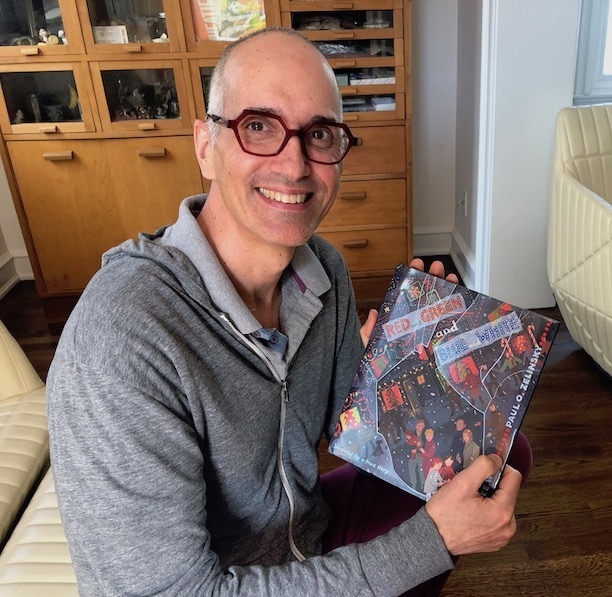
Backstory: Q & A with Lee Wind
Judy Bradbury: How did you come to write Red and Green and Blue and White? What kernel seeded its creation?
Lee Wind: There was this amazing true story from December 1993 in Billings, Montana that got a lot of attention (including national press coverage on NPR and in the New York Times, a PBS documentary, and the formation of the nonprofit Not in Our Town.) Billings was a town where there had been a handful of hate crimes leading up to the holiday season in 1993. Most folks there celebrated Christmas. Isaac was a little boy whose family celebrated Chanukah. One night someone threw a stone through Isaac’s window that was decorated with a menorah and stars of David, and the family had to decide, once the window was replaced, were they going to put up their holiday decorations again, or were they going to hide being Jewish? They decided to stand up for themselves. Friends of Isaac in his kindergarten class drew images of menorahs in support, and those symbols of Chanukah started to get put up in windows next to people’s Christmas decorations. The local newspaper, the Billings Gazette, published a full-page image of a menorah with an editorial, urging citizens to “display the menorah as a symbol of … our determination to live together in harmony, and our dedication to the principle of religious liberty embodied in the First Amendment to the Constitution of the United States of America.” In just a few weeks more than 10,000 menorahs went up in the windows of homes and stores and libraries all over Billings. And when the whole community stood up together, the haters backed down. And in Billings, love won.
It’s a complicated story, but at its heart it’s about standing up for yourself, and standing up for others, and I thought it could make an amazing picture book for 4-8 year-olds.
JB: Tell about one hurdle you experienced in the creation of Red and Green and Blue and White or provide a memorable (or humorous!) anecdote related to the making of this book.
LW: The biggest hurdle was letting go of the many, many, many details and facts about what happened and pulling back to write a fictional story inspired by the true events. The breakthrough came when I thought about the decorations, how red and green are Christmas colors, and blue and white are Chanukah colors… And then, the idea of the story being told with the metaphor of colors, Red and Green and Blue and White.
JB: How did you decide what to fictionalize and what details of the real events to include?
LW: I kept only the basic structure of what happened – as I say in the author’s note, “This book was inspired by the real events of December 1993 in Billings, Montana. Teresa and Isaac are real people too, though I have fictionalized their interactions and some details of how things unfolded. What I hope shines through is how the people in Billings chose to not just stand by and be BYstanders while bad things happened to others. Instead, they stood up to say the bad things weren’t okay. They chose to be UPstanders…”
JB: What did you learn from creating Red and Green and Blue and White?
LW: I wanted to make the theme of standing up for yourself and standing up for others evident without being preachy. With Isaac and Teresa’s friendship I could show standing up for yourself and standing up for others. But what those fictional characters (named after the real people to honor them) really needed was agency. I made Teresa an artist, so she would naturally draw a menorah in support of her friend. And I made Isaac a poet, to be a second, kid-accessible narrative of what was happening.
JB: What would surprise readers to learn about you or about the creation of Red and Green and Blue and White?
LW: It’s fun that a story about the power and meaning of community was created with help from a community, too. Back when it was a manuscript, the amazing Jane Yolen gave me some feedback about Isaac’s poems. At the time, they were almost like the chorus to a song – Jane’s suggestion was to let them build, two lines, then the next time three lines, then the final time four lines. It was genius – I’m still amazed at how cutting those words made the whole thing so much more powerful! And then, once the manuscript found its publishing home with Arthur A. Levine at his new publishing house Levine Querido, Arthur gave me great feedback to make the manuscript even better. And then, when none other than the incredible Caldecott-winning Paul O. Zelinsky agreed to illustrate the manuscript, it transformed from “my” book to “our” book. It’s my debut picture book, and I’m so proud of what we all created.
JB: One of the themes in Red and Green and Blue and White isthe importance of being an UPstander rather than a BYstander. You refer to this briefly in the Author’s Note. Tell us why this distinction resonates with you.
LW: I love the term “UPstander.” There’s no such thing as a silent ally – just being a bystander, quietly watching injustice, does nothing to stop that injustice. It’s not a neutral position.
Think of it this way: person 1 does something to hurt person 2, person 3 is a bystander who sees it happen and does nothing, person 4 sees it happen and does something – having a name for that type of person 4 is powerful: UPstander. And credit for that term, I believe, goes to the nonprofit Facing History and Ourselves.
JB: What do you hope readers will take away from Red and Green and Blue and White?
LW: That no matter how old you are – even if you’re a kid – you can stand up for yourself, and you can stand up for someone you care about. You can draw a picture. You can write a poem. You can make our world a better place, right now.
JB: How do you see Red and Green and Blue and White connecting to curriculum?
LW: Booklist said the book could be “a springboard to discussions of prejudice” and that would be wonderful. I hope Red and Green and Blue and White is told in a way that lets kids feel the emotions and still know they’re safe. Ultimately, I hope they are empowered.
JB: You’ve previously published two books. Tell us about them.
LW: I’m the author of the nonfiction No Way, They Were Gay? Hidden Lives and Secret Loves, a Junior Library Guild gold standard selection, and the YA novel Queer as a Five-Dollar Bill, a Publishers Weekly “Indie Success Story.”
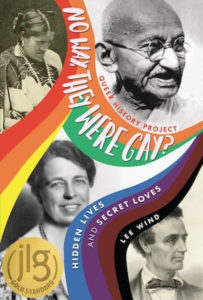
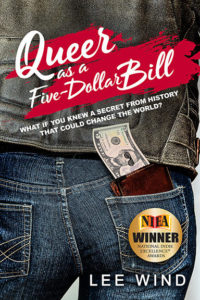
JB: What is one question you wish I had asked, and what is your answer?
LW: You could ask: This is your debut picture book – is it the first one you’ve written?
And here is my answer: Gosh, no! I’ve been working on picture book manuscripts since 2004. Red and Green and Blue and White is the first to find a publishing home, and the first to be published! Maybe the reason is that the manuscript managed to tap into the emotional power of the true story that inspired it – I still get goosebumps when I read it!
Thank you so much for this opportunity, Judy! I’m excited for Red and Green and Blue and White to find readers and help us all shine with the true meaning of the holidays and the true meaning of community!
About the Illustrator
Over to You…
Join the conversation! Offer your thoughts on the featured question related to this month’s post. You are also welcome to post a general comment.
What recently published holiday book celebrating inclusion do you recommend? Share the title and author of the book in the comments section.
Thanks for sharing!
News & Updates
One of my favorite emails this past month included this excerpt: “My friend’s grandson read your first book, asked for the second book, and wanted to know if there was a third book…and this is coming from a pure jock who is on two hockey teams–a travel and a local–you got his interest, I would say!”
It had me smiling.
Hop on over here to find a variety of Cayuga Island Kid activities to share with kids.
Wishing you, my cherished subscribers and readers, a safe, happy, hope-and-light-filled holiday season. Thanks for being a part of the Children’s Book Corner family!
Final Thought
“Ultimately, we have just one moral duty: to reclaim large areas of peace in ourselves, more and more peace, and to reflect it towards others. And the more peace there is in us, the more peace there will also be in our troubled world.” ~ Etty Hillesum

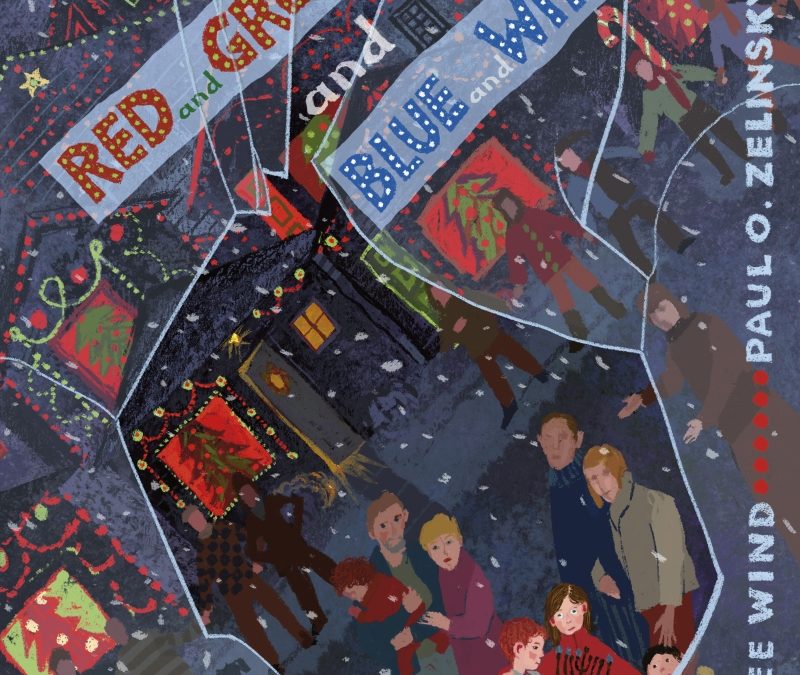
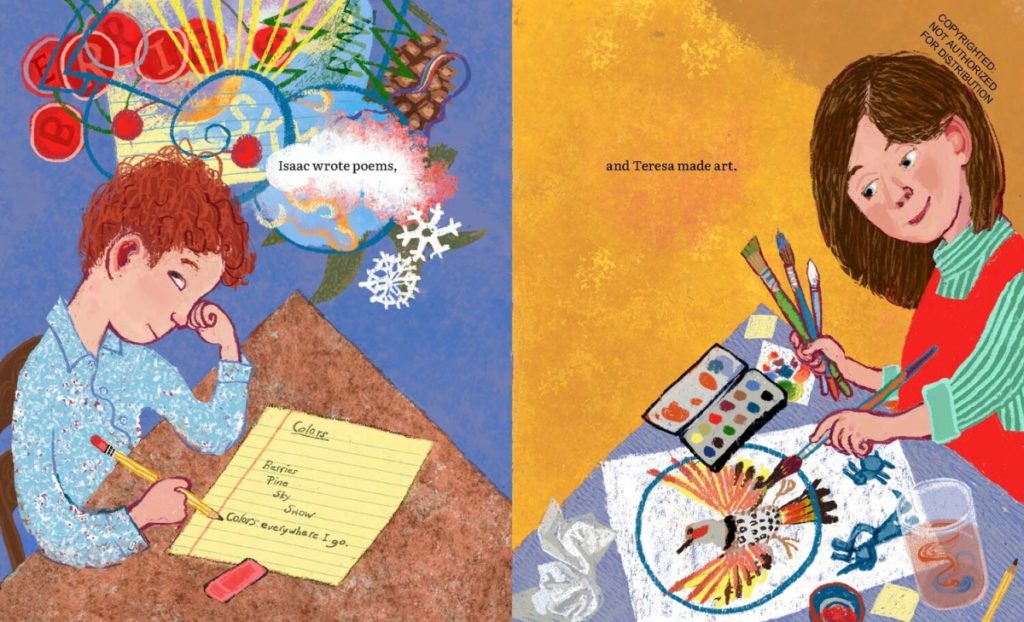
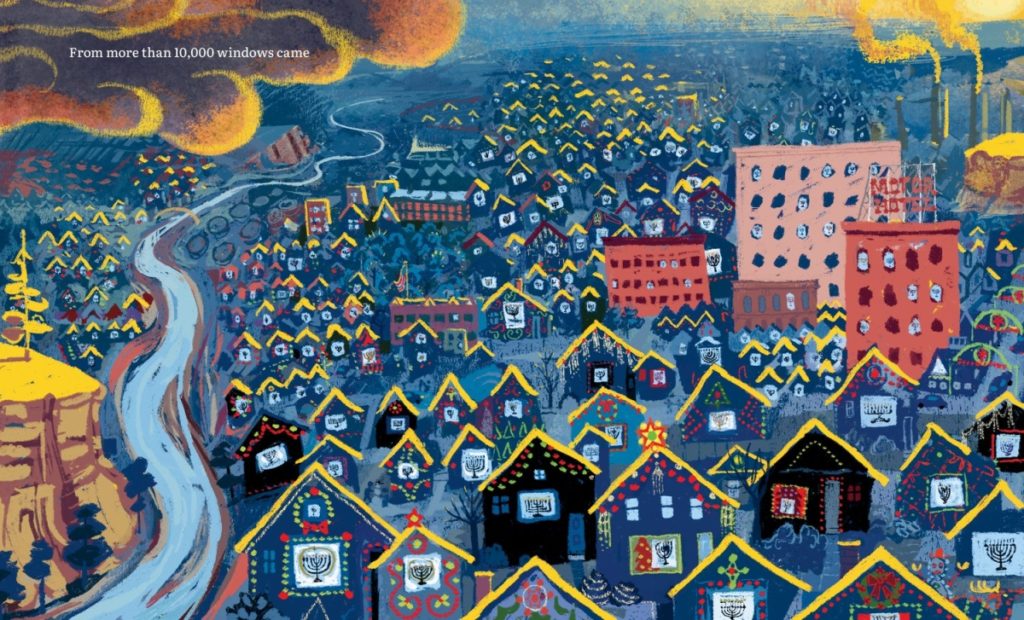
This sounds like such an incredible and heart-warming book, and I know that with Paul Zelinski’s illustrations it will look beautiful as well as being beautifully told. I bopped off of this page to follow all your links (it’s wonderful how you provide those, Judy!) but also to go to my local independent book seller to order a copy before I could even finish reading. I love Christmas and Christmas stories, but so often holiday stories can be a bit TOO sweet, or to focus on the wrong things. This book is made more meaningful because it’s based on a real incident. Thanks for letting people know about Red and Green and Blue and White. It’s a true Christmas (and Hannukah) gift.
Thanks for your kind comments, Vivian. It’s always a pleasure to hear from you. I agree that this is a heart-warming story, all the more so because it is based on real events; and yes, Paul’s illustrations are as beautiful as Lee’s telling. I was delighted to feature RED AND GREEN AND BLUE AND WHITE on Children’s Book Corner as the holiday selection.